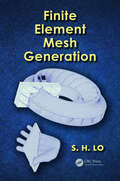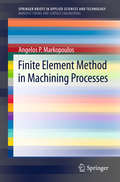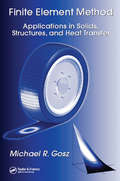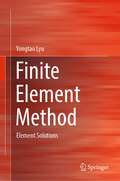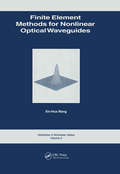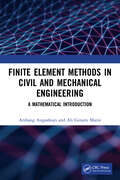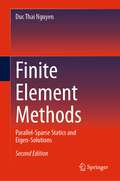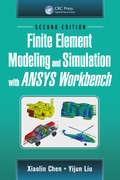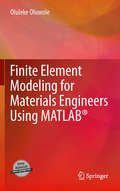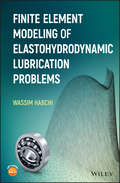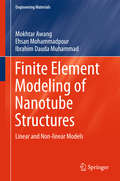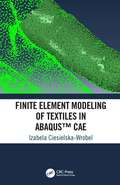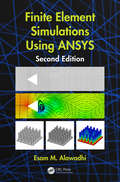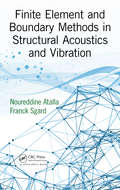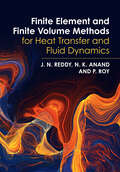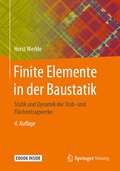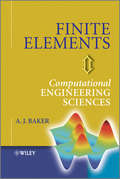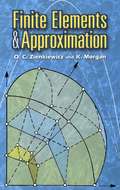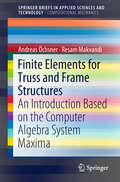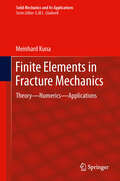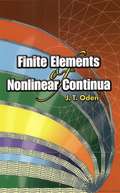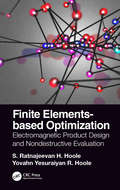- Table View
- List View
Finite Element Mesh Generation
by Daniel S.H. LoHighlights the Progression of Meshing Technologies and Their ApplicationsFinite Element Mesh Generation provides a concise and comprehensive guide to the application of finite element mesh generation over 2D domains, curved surfaces, and 3D space. Organised according to the geometry and dimension of the problem domains, it develops from the basic m
Finite Element Method Analysis for Ice Class Vessels (Synthesis Lectures on Ocean Systems Engineering)
by Alexander Arnfinn OlsenThis book provides ship designers with clear guidance on alternative design procedures for hull side structures, power requirements, and propeller strength assessment based on the Finite Element Method for Baltic Ice Class Vessels. Through this comprehensive guide, readers will learn the intricacies of designing vessels capable of navigating the harsh ice conditions of the Baltic Sea. The chapters cover topics such as ice strengthening designs using direct calculation approaches, power requirement calculations for ice class vessels, and strength analysis of propellers. The authors present an expert analysis of these critical aspects, offering practical solutions and methodologies that are essential for marine engineers and naval architects. This book is a must-read for anyone involved in the design and construction of ice-class vessels, providing invaluable insights into the latest research and best practices in the field. This guide is indispensable for naval architects, marine engineering students, marine surveyors, and professionals working in maritime defense and shipping registries. It serves as a reference for academics and students in marine design and engineering, as well as a textbook for marine engineering courses. With contributions from experienced practitioners in the field, this book offers both theoretical perspectives and practical case studies that will benefit anyone involved in the design and operation of ice-class vessels.
Finite Element Method in Machining Processes
by Angelos P. MarkopoulosFinite Element Method in Machining Processes provides a concise study on the way the Finite Element Method (FEM) is used in the case of manufacturing processes, primarily in machining. The basics of this kind of modeling are detailed to create a reference that will provide guidelines for those who start to study this method now, but also for scientists already involved in FEM and want to expand their research. A discussion on FEM, formulations, and techniques currently in use is followed up by machining case studies. Orthogonal cutting, oblique cutting, 3D simulations for turning and milling, grinding, and state-of-the-art topics such as high speed machining and micromachining are explained with relevant examples. This is all supported by a literature review and a reference list for further study. As FEM is a key method for researchers in the manufacturing and especially in the machining sector, Finite Element Method in Machining Processes is a key reference for students studying manufacturing processes but also for industry professionals.
Finite Element Method: Applications in Solids, Structures, and Heat Transfer (Mechanical Engineering)
by Michael R. GoszThe finite element method (FEM) is the dominant tool for numerical analysis in engineering, yet many engineers apply it without fully understanding all the principles. Learning the method can be challenging, but Mike Gosz has condensed the basic mathematics, concepts, and applications into a simple and easy-to-understand reference.Finite Element Method: Applications in Solids, Structures, and Heat Transfer navigates through linear, linear dynamic, and nonlinear finite elements with an emphasis on building confidence and familiarity with the method, not just the procedures. This book demystifies the assumptions made, the boundary conditions chosen, and whether or not proper failure criteria are used. It reviews the basic math underlying FEM, including matrix algebra, the Taylor series expansion and divergence theorem, vectors, tensors, and mechanics of continuous media.The author discusses applications to problems in solid mechanics, the steady-state heat equation, continuum and structural finite elements, linear transient analysis, small-strain plasticity, and geometrically nonlinear problems. He illustrates the material with 10 case studies, which define the problem, consider appropriate solution strategies, and warn against common pitfalls. Additionally, 35 interactive virtual reality modeling language files are available for download from the CRC Web site.For anyone first studying FEM or for those who simply wish to deepen their understanding, Finite Element Method: Applications in Solids, Structures, and Heat Transfer is the perfect resource.
Finite Element Method: Element Solutions
by Yongtao LyuThis textbook is intended to be used by the senior engineering undergraduate and the graduate student. Nowadays, the finite element method has become one of the most widely used techniques in all the engineering fields, including aerospace engineering, mechanical engineering, biomedical engineering, etc. To unveil the FE technique, the textbook provides a detailed description of the finite element method, starting from the most important basic theoretical basis, e.g., the Galerkin method, the variational principle, followed by the detailed description of the various types of finite elements, including the bar, the beam, the triangular, the rectangular, the 3D elements. The primary aim of the textbook is to provide a comprehensive description of the FE solutions using different types of elements. Therefore, the properties of different elements and the solution discrepancies caused by using different elements are highlighted in the book. Thus, the textbook is very helpful for engineers to understand the behaviours of different types of elements. Additionally, the textbook can help the students and engineers write FE codes based on the theories presented in the book. Furthermore, the textbook can serve as the basis for some advanced computational mechanics courses, such as the nonlinear finite element method.
Finite Element Methods for Nonlinear Optical Waveguides
by Xin-Hua WangThis book provides researchers at the forefront of nonlinear optical technologies with robust procedures and software for the systematic investigation of the fundamental phenomena in nonlinear optical waveguide structures. A full vectorial electromagnetic formulation is adopted and the conditions under which simplification to a scalar formulation is possible are clearly indicated. The need to model the dielectric saturation properly is identified, and improved algorithms are presented for obtaining the complete power dispersion curve of structures exhibiting bistability. As the stability analysis of nonlinear modes is crucial to the development of nonlinear model methods, an effective procedure to investigate the propagation of the scalar nonlinear waves in 3D is another important feature of the book. All of the procedures described, as well as an automatic mesh generator for the finite element method, are incorporated into a software package which is included with this book.
Finite Element Methods in Civil and Mechanical Engineering: A Mathematical Introduction
by Arzhang Angoshtari Ali Gerami MatinThe finite element method is widely employed for numerical simulations in engineering and science due to its accuracy and efficiency. This concise introduction to the mathematical theory of the finite element method presents a selection of applications in civil and mechanical engineering including beams, elastic membranes, the wave equation, heat transfer, seepage in embankment, soil consolidation, incompressible fluids, and linear elasticity. Jupyter notebooks containing all Python programs of each chapter can be downloaded from the book's companion website. Arzhang Angoshtari is an assistant professor and Ali Gerami Matin is a graduate student, both in the department of Civil and Environmental Engineering at the George Washington University, USA. Their research interests cover theoretical and computational mechanics and finite element methods.
Finite Element Methods: Parallel-Sparse Statics and Eigen-Solutions
by Duc Thai NguyenThis new edition includes three new chapters, 7 through 9, that have very broad, practical applications in engineering and science. In addition, the author’s latest research results incorporated into the new textbook demonstrates better performance than the popular METIS software for partitioning graphs, partitioning finite element meshes, and producing fill-reducing orderings for sparse matrices. The new Chapter 8, and its pre-requisite, Chapter 7, present a state-of-the-art algorithm for computing the shortest paths for real-life (large-scale) transportation networks with minimum computational time. This approach has not yet appeared in any existing textbooks and it could open the doors for other transportation engineering applications. Chapter 9 vastly expands the scope of the previous edition by including sensitivity (gradient) computation and MATLAB’s built-in function “fmincon” for obtaining the optimum (or best) solution for general engineering problems.
Finite Element Modeling and Simulation with ANSYS Workbench, Second Edition
by Yijun Liu Xiaolin ChenFinite Element Modeling and Simulation with ANSYS Workbench 18, Second Edition, combines finite element theory with real-world practice. Providing an introduction to finite element modeling and analysis for those with no prior experience, and written by authors with a combined experience of 30 years teaching the subject, this text presents FEM formulations integrated with relevant hands-on instructions for using ANSYS Workbench 18. Incorporating the basic theories of FEA, simulation case studies, and the use of ANSYS Workbench in the modeling of engineering problems, the book also establishes the finite element method as a powerful numerical tool in engineering design and analysis. Features Uses ANSYS Workbench™ 18, which integrates the ANSYS SpaceClaim Direct Modeler™ into common simulation workflows for ease of use and rapid geometry manipulation, as the FEA environment, with full-color screen shots and diagrams. Covers fundamental concepts and practical knowledge of finite element modeling and simulation, with full-color graphics throughout. Contains numerous simulation case studies, demonstrated in a step-by-step fashion. Includes web-based simulation files for ANSYS Workbench 18 examples. Provides analyses of trusses, beams, frames, plane stress and strain problems, plates and shells, 3-D design components, and assembly structures, as well as analyses of thermal and fluid problems.
Finite Element Modeling for Materials Engineers Using MATLAB®
by Oluleke OluwoleThe finite element method is often used for numerical computation in the applied sciences. It makes a major contribution to the range of numerical methods used in the simulation of systems and irregular domains, and its importance today has made it an important subject of study for all engineering students. While treatments of the method itself can be found in many traditional finite element books, Finite Element Modeling for Materials Engineers Using MATLAB® combines the finite element method with MATLAB to offer materials engineers a fast and code-free way of modeling for many materials processes. Finite Element Modeling for Materials Engineers Using MATLAB® covers such topics as: developing a weak formulation as a prelude to obtaining the finite element equation,interpolation functions,derivation of elemental equations, anduse of the Partial Differential Equation ToolboxTM.Exercises are given based on each example and m-files based on the examples are freely available to readers online. Researchers, advanced undergraduate and postgraduate students, and practitioners in the fields of materials and metallurgy will find Finite Element Modeling for Materials Engineers Using MATLAB® a useful guide to using MATLAB for engineering analysis and decision-making.
Finite Element Modeling of Elastohydrodynamic Lubrication Problems
by Wassim HabchiCovers the latest developments in modeling elastohydrodynamic lubrication (EHL) problems using the finite element method (FEM) This comprehensive guide introduces readers to a powerful technology being used today in the modeling of elastohydrodynamic lubrication (EHL) problems. It provides a general framework based on the finite element method (FEM) for dealing with multi-physical problems of complex nature (such as the EHL problem) and is accompanied by a website hosting a user-friendly FEM software for the treatment of EHL problems, based on the methodology described in the book. Finite Element Modeling of Elastohydrodynamic Lubrication Problems begins with an introduction to both the EHL and FEM fields. It then covers Standard FEM modeling of EHL problems, before going over more advanced techniques that employ model order reduction to allow significant savings in computational overhead. Finally, the book looks at applications that show how the developed modeling framework could be used to accurately predict the performance of EHL contacts in terms of lubricant film thickness, pressure build-up and friction coefficients under different configurations. Finite Element Modeling of Elastohydrodynamic Lubrication Problems offers in-depth chapter coverage of Elastohydrodynamic Lubrication and its FEM Modeling, under Isothermal Newtonian and Generalized-Newtonian conditions with the inclusion of Thermal Effects; Standard FEM Modeling; Advanced FEM Modeling, including Model Order Reduction techniques; and Applications, including Pressure, Film Thickness and Friction Predictions, and Coated EHL. This book: Comprehensively covers the latest technology in modeling EHL problems Focuses on the FEM modeling of EHL problems Incorporates advanced techniques based on model order reduction Covers applications of the method to complex EHL problems Accompanied by a website hosting a user-friendly FEM-based EHL software Finite Element Modeling of Elastohydrodynamic Lubrication Problems is an ideal book for researchers and graduate students in the field of Tribology.
Finite Element Modeling of Nanotube Structures
by Mokhtar Awang Ehsan Mohammadpour Ibrahim Dauda MuhammadThis book presents a new approach to modeling carbon structures such as graphene and carbon nanotubes using finite element methods, and addresses the latest advances in numerical studies for these materials. Based on the available findings, the book develops an effective finite element approach for modeling the structure and the deformation of grapheme-based materials. Further, modeling processing for single-walled and multi-walled carbon nanotubes is demonstrated in detail.
Finite Element Modeling of Textiles in Abaqus™ CAE
by Izabela Ciesielska-WrobelThe aim of the book is to provide engineers with a practical guide to Finite Element Modelling (FEM) in Abaqus CAE software. The guide is in the form of step-by-step procedures concerning yarns, woven fabric and knitted fabrics modelling, as well as their contact with skin so that the simulation of haptic perception between textiles and skin can be
Finite Element Simulations Using ANSYS
by Esam M. AlawadhiUses a Step-By-Step Technique Directed with Guided Problems and Relevant Screen Shots Simulation use is on the rise, and more practicing professionals are depending on the reliability of software to help them tackle real-world mechanical engineering problems. Finite Element Simulations Using ANSYS, Second Edition offers a basic understanding of the
Finite Element and Boundary Methods in Structural Acoustics and Vibration
by Noureddine Atalla Franck SgardEffectively Construct Integral Formulations Suitable for Numerical ImplementationFinite Element and Boundary Methods in Structural Acoustics and Vibration provides a unique and in-depth presentation of the finite element method (FEM) and the boundary element method (BEM) in structural acoustics and vibrations. It illustrates the principles using a
Finite Element and Finite Volume Methods for Heat Transfer and Fluid Dynamics
by J. N. Reddy N. K. Anand P. RoyIntroduces the two most common numerical methods for heat transfer and fluid dynamics equations, using clear and accessible language. This unique approach covers all necessary mathematical preliminaries at the beginning of the book for the reader to sail smoothly through the chapters. Students will work step-by-step through the most common benchmark heat transfer and fluid dynamics problems, firmly grounding themselves in how the governing equations are discretized, how boundary conditions are imposed, and how the resulting algebraic equations are solved. Providing a detailed discussion of the discretization steps and time approximations, and clearly presenting concepts of explicit and implicit formulations, this graduate textbook has everything an instructor needs to prepare students for their exams and future careers. Each illustrative example shows students how to draw comparisons between the results obtained using the two numerical methods, and at the end of each chapter they can test and extend their understanding by working through the problems provided. A solutions manual is also available for instructors.
Finite Elemente in der Baustatik: Statik und Dynamik der Stab- und Flächentragwerke
by Horst WerkleDie Finite-Element-Methode ist heute ein Standardverfahren zur Berechnung von Stab-, Flächen- und Raumtragwerken im konstruktiven Ingenieurbau mit Hilfe des Computers. Ihre sachgemäße Anwendung erfordert das Verständnis der Grundlagen der Methode sowie gute Kenntnisse in der Modellierung des Tragwerks. Dieses Buch will beides vermitteln. Der didaktisch sehr gute Aufbau des Buches, unterstützt durch viele aussagefähige Beispiele, macht das Erlernen und Anwenden der Finite-Element-Methode leicht möglich.Das Buch behandelt wichtige Fragen zur Finite-Element-Methode. Wie funktioniert die Methode? Was sind die Merkmale einer Finite-Element-Näherung? Wie können Fallstricke bei der Finite-Elemente-Modellierung vermieden werden und wie werden die Ergebnisse richtig interpretiert? Die Finite-Elemente-Theorie wird "so einfach wie möglich" dargestellt und mit vielen Beispielen veranschaulicht. Ziel ist es, das grundlegende theoretische Wissen verständlich zu vermitteln, das bei der professionellen Anwendung komplexer Finite-Element-Software in der Praxis erforderlich ist. Auch anspruchsvolle baudynamische Untersuchungen und nichtlineare Berechnungen werden behandelt.Für die 4. Auflage wurde das Buch grundlegend überarbeitet. Inhaltlich neu sind die vertiefte Behandlung dreidimensionaler Strukturen, der Boden-Bauwerk-Wechselwirkung und von Gesamtgebäudemodellen.
Finite Elements
by A. J. BakerApproaches computational engineering sciences from the perspective of engineering applicationsUniting theory with hands-on computer practice, this book gives readers a firm appreciation of the error mechanisms and control that underlie discrete approximation implementations in the engineering sciences.Key features:Illustrative examples include heat conduction, structural mechanics, mechanical vibrations, heat transfer with convection and radiation, fluid mechanics and heat and mass transportTakes a cross-discipline continuum mechanics viewpointIncludes Matlab toolbox and .m data files on a companion website, immediately enabling hands-on computing in all covered disciplines Website also features eight topical lectures from the author's own academic coursesIt provides a holistic view of the topic from covering the different engineering problems that can be solved using finite element to how each particular method can be implemented on a computer. Computational aspects of the method are provided on a companion website facilitating engineering implementation in an easy way.
Finite Elements and Approximation (Dover Books on Engineering)
by K. Morgan O. C. ZienkiewiczA powerful tool for the approximate solution of differential equations, the finite element is extensively used in industry and research. This book offers students of engineering and physics a comprehensive view of the principles involved, with numerous illustrative examples and exercises.Starting with continuum boundary value problems and the need for numerical discretization, the text examines finite difference methods, weighted residual methods in the context of continuous trial functions, and piecewise defined trial functions and the finite element method. Additional topics include higher order finite element approximation, mapping and numerical integration, variational methods, and partial discretization and time-dependent problems. A survey of generalized finite elements and error estimates concludes the text.
Finite Elements for Truss and Frame Structures: An Introduction Based On The Computer Algebra System Maxima (SpringerBriefs in Applied Sciences and Technology)
by Andreas Öchsner Resam MakvandiThis book is intended as an essential study aid for the finite element method. Based on the free computer algebra system Maxima, the authors offer routines for symbolically or numerically solving problems in the context of plane truss and frame structures, allowing readers to check classical ‘hand calculations’ on the one hand and to understand the computer implementation of the method on the other. The mechanical theories focus on the classical one-dimensional structural elements, i.e. bars, Euler–Bernoulli and Timoshenko beams, and their combination to generalized beam elements. Focusing on one-dimensional elements reduces the complexity of the mathematical framework, and the resulting matrix equations can be displayed with all components and not merely in the form of a symbolic representation. In addition, the use of a computer algebra system and the incorporated functions, e.g. for equation solving, allows readers to focus more on the methodology of the finite element method and not on standard procedures.
Finite Elements in Civil Engineering Applications: Proceedings of the Third Diana World Conference, Tokyo, Japan, 9-11 October 2002
by Max A.N. Hendriks; Jan G. RotsThese proceedings present high-level research in structural engineering, concrete mechanics and quasi-brittle materials, including the prime concern of durability requirements and earthquake resistance of structures.
Finite Elements in Fracture Mechanics: Theory - Numerics - Applications
by Meinhard KunaFracture mechanics has established itself as an important discipline of growing interest to those working to assess the safety, reliability and service life of engineering structures and materials. In order to calculate the loading situation at cracks and defects, nowadays numerical techniques like finite element method (FEM) have become indispensable tools for a broad range of applications. The present monograph provides an introduction to the essential concepts of fracture mechanics, its main goal being to procure the special techniques for FEM analysis of crack problems, which have to date only been mastered by experts. All kinds of static, dynamic and fatigue fracture problems are treated in two- and three-dimensional elastic and plastic structural components. The usage of the various solution techniques is demonstrated by means of sample problems selected from practical engineering case studies. The primary target group includes graduate students, researchers in academia and engineers in practice.
Finite Elements in Structural Analysis: Theoretical Concepts and Modeling Procedures in Statics and Dynamics of Structures (Springer Tracts in Civil Engineering)
by Horst WerkleThe book introduces the basic concepts of the finite element method in the static and dynamic analysis of beam, plate, shell and solid structures, discussing how the method works, the characteristics of a finite element approximation and how to avoid the pitfalls of finite element modeling. Presenting the finite element theory as simply as possible, the book allows readers to gain the knowledge required when applying powerful FEA software tools. Further, it describes modeling procedures, especially for reinforced concrete structures, as well as structural dynamics methods, with a particular focus on the seismic analysis of buildings, and explores the modeling of dynamic systems. Featuring numerous illustrative examples, the book allows readers to easily grasp the fundamentals of the finite element theory and to apply the finite element method proficiently.
Finite Elements of Nonlinear Continua (Dover Civil and Mechanical Engineering)
by J. T. OdenGeared toward undergraduate and graduate students, this text extends applications of the finite element method from linear problems in elastic structures to a broad class of practical, nonlinear problems in continuum mechanics. It treats both theory and applications from a general and unifying point of view.The text reviews the thermomechanical principles of continuous media and the properties of the finite element method, and then brings them together to produce discrete physical models of nonlinear continua. The mathematical properties of these models are analyzed, along with the numerical solution of the equations governing the discrete model. Though the theory and methods are sufficiently general to be applied to any nonlinear problem, emphasis has been placed on problems in finite elasticity, viscoelasticity, heat conduction, and thermoviscoelasticity. Problems in rarefied gas dynamics and nonlinear partial differential equations are also examined.Other topics include topological properties of finite element models, applications to linear and nonlinear boundary value problems, and discrete models of nonlinear thermomechanical behavior of dissipative media. This comprehensive text is valuable not only to students of structural analysis and continuum mechanics but also to professionals researching the numerical analysis of continua
Finite Elements-based Optimization: Electromagnetic Product Design and Nondestructive Evaluation
by S. Hoole Yovahn HooleThis book is intended to be a cookbook for students and researchers to understand the finite element method and optimization methods and couple them to effect shape optimization. The optimization part of the book will survey optimization methods and focus on the genetic algorithm and Powell’s method for implementation in the codes. It will contain pseudo-code for the relevant algorithms and homework problems to reinforce the theory to compile finite element programs capable of shape optimization. Features Enables readers to understand the finite element method and optimization methods and couple them to effect shape optimization Presents simple approach with algorithms for synthesis Focuses on automated computer aided design (CAD) of electromagnetic devices Provides a unitary framework involving optimization and numerical modelling Discusses how to integrate open-source mesh generators into your code Indicates how parallelization of algorithms, especially matrix solution and optimization, may be approached cheaply using the graphics processing unit (GPU) that is available on most PCs today Includes coupled problem optimization using hyperthermia as an example
